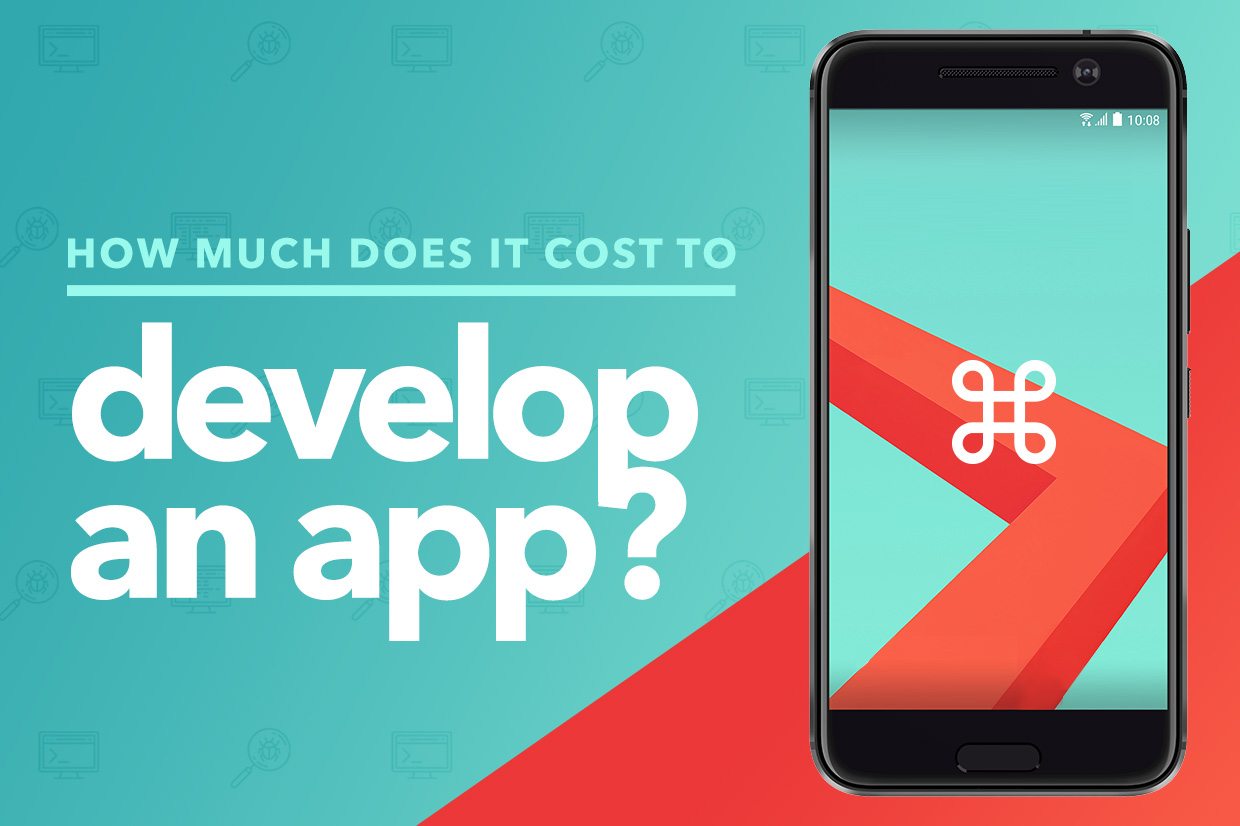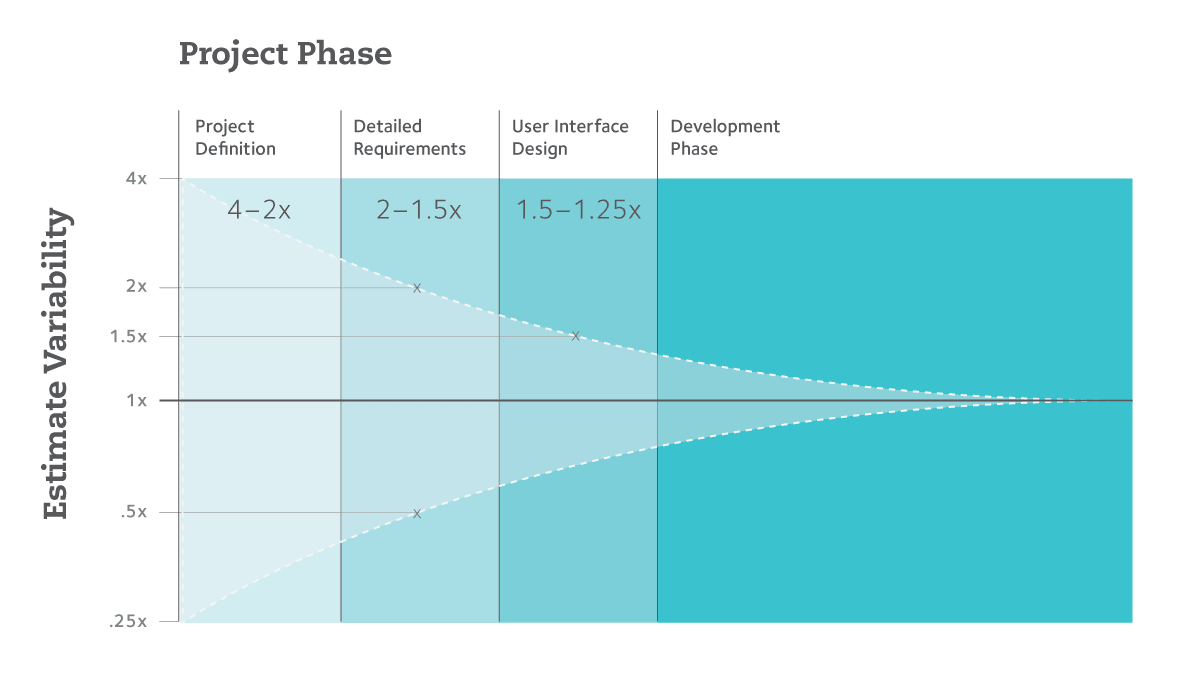
8 min read
How much does it cost to make an app?
How Much Does it Cost to Build a Mobile App?
This article addresses mobile application development cost using the cone of uncertainty. Discover how to minimize risk and get an accurate estimate before you start developing.
Editor’s note: This piece was originally published in 2017. It’s been so popular that we updated it in 2019.
How much does it cost to make a mobile app? We don’t know. At least, not yet. And neither do any of the other software companies you may have asked.
What we mean is, to provide an accurate estimation of the cost to create an app, we’ll need more information.
Before you can begin to estimate prices, everyone involved – you, your boss, and your stakeholders – needs more information. To begin gathering this information, there are a few questions about your mobile app development project that you should ask upfront.
- What business value will your mobile app create?
- Is it solving the right problems?
- Will end-users actually use it?
- How will it behave on different mobile devices?
- What will make it easy to use?
The answers will help you determine the mobile app’s purpose and function, or what it will do and why. This information is essential to accurately quoting mobile app development cost. Having an accurate quote allows decision-makers to determine what form the app should take for it to be worth the investment.
Accurate quotes allow businesses to filter out mobile app ideas that aren’t worth the investment, as well as ideas they simply can’t afford. If you’ve ever been prevented from building an app you can’t afford, you should thank your lucky stars! It may have been disappointing at the time, but you avoided wasting large sums of money on starting a project you couldn’t finish or starting a project that wouldn’t have produced real value for your business.
>> Check out our exposé on Why Software Projects Fail.
The most accurate and helpful answer to the question of cost to create an app is not the quickest one, yet understanding real mobile app development costs upfront is essential. Starting with an accurate quote can save you a good deal of time, money, and maybe even your job.
Accurately Estimate Mobile App Development Cost Using the Cone of Uncertainty
An estimate’s accuracy depends on how far along you are in designing your mobile app. At the beginning of your project you’re still figuring out your idea and basic value proposition, which is the Product Definition phase. During the Product Definition phase, the answers to questions about the validity of the mobile app and how exactly it will prove valuable are uncertain. Perhaps you have hunches, but those hunches are largely based on assumptions.
If you receive an estimate during the Product Definition phase, that estimate will likely be off by as much as 400% in either direction. In other words, a $100,000 quote for custom app development could actually cost you any amount between $400,000 to $25,000 by the end of the project. At this point, the quote is not trustworthy because there is simply not enough information about the proposed mobile application to know how difficult or time-consuming development will be.
Years of research by software-cost gurus Barry Boehm and Steve McConnell describe this phenomenon using the “Cone of Uncertainty.” We use the Cone of Uncertainty to coach potential clients on obtaining accurate estimates for custom software development, to help them avoid risky situations with mobile app development vendors.
The Cone of Uncertainty

Once you’ve solidified the concept and purpose for your mobile app, you’ll move along the Cone of Uncertainty from the Product Definition phase into the Requirements Gathering phase. During this phase you produce detailed descriptions of exactly how you imagine users interacting with your mobile app. You will likely write user stories and other forms of documentation, often with the assistance of a professional technical writer.
Requirements Gathering narrows the accuracy of cost estimates for mobile app development a good deal, reducing variance from 400% to 100%. Yet, for most businesses, committing to a quote that could be off by 100% is still too risky. While the project plans are far more detailed now than they were during the Product Definition stage, these details are based almost completely on conjecture about the mobile app’s value and usability. It’s simply not responsible to commit to a quote before or during the Requirements Gathering phase of product development.
Any development company that provides you with a hard and fast quote during this stage is likely to reset your expectations or redefine scope later on in the project. Written software requirements leave a lot of room for interpretation, and are not a safe foundation for entering into a development contract on their own.
>> Usability Testing: How to validate your assumptions and build software with confidence
So How Much Does it Cost to Develop an App? The Answer is in a Prototype
We’re getting closer!
It’s only after you design the user interface and prototype that projects reach a 20-50% level of variance between an app’s anticipated development cost and actual cost. At this point, the risk of failing to develop a mobile app that’s both functional and affordable is low enough for most businesses to responsibly commit and move forward.
>> Learn more about ClickModel, our trademarked solution for software prototyping.
What makes the User Interface Design Stage so climactic? Up until this phase, almost everything about your product is untested, making it uncertain whether or not you will see a valuable return on your investment.
Engaging with the user interface through a working prototype provides your team with the opportunity to conduct usability testing, and subsequently course correct your project as needed. You’ll be able to make smart decisions about the purpose and limitations of the mobile app, and how approachable it will be to users. The information gathered during user testing will illuminate the path toward relevant design that succeeds with end users.
Interacting with a prototype of your mobile app allows you to experience a level of engagement impossible with a wireframe or mockup. With hands-on testing, you’ll face areas of the design you hadn’t even thought about, such as on-screen behaviors, transitions, form interactions, and conditional display of elements based on screen size.
>> Find out more about the importance of user experience design for your bottom line, and see how it ensures user acceptance and informs development at every stage of the project.
See it in Action: Praxent’s Mobile App Pricing Timeline
At Praxent, we prioritize keeping promises and meeting expectations, especially when it comes to the cost of custom mobile app development. Here’s how we carefully and thoughtfully determine the cost to make a mobile app:
Product Definition Stage: No quote
Detailed Requirements Stage: Estimate general cost based on client’s budget and perceived difficulty of the project
User Interface Design Stage: Complete the following
- Create a ClickModel prototype within the estimated budget
- Re-prioritize project objectives and features where appropriate
- Finalize quote using findings from ClickModel discovery
Development Stage: Confidently develop the app with clear vision and minimal risk!

Keeping the Development Team Accountable
Many app development companies let the meter run with no end in sight, while others handicap the project with a fixed price. At Praxent, we develop mobile apps that have the greatest impact possible on your business objectives, and we allow budget and timeline to guide the process.
Together with our clients, we identify features that will have the greatest impact on the app’s success. We also agree on “project principles” to keep development focused on those features. If discoveries down the road reveal alternate features or processes that would better serve project goals, we work with you to reassess our current course and perhaps change direction.
>> Learn more about project principles for on track, flexible, and results-oriented app development.
We won’t put you in a position where you have to report to the company’s vice president without a mobile app that returns on investment. With a balanced perspective on your mobile app’s development costs and timeline, we make ourselves more accountable to your business objectives. Learn more about the Praxent approach to mission-critical app development projects.



Leave a Reply